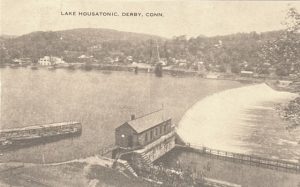By Joseph M. DiRienzo

Early 20th century postcard of the Derby-Shelton Dam and Lake Housatonic viewed from the Shelton side of the river – Joseph DiRienzo
A group of local industrialists, headed by Edward Nelson Shelton, created the Ousatonic Water Company shortly after the Civil War. A major accomplishment of the company was the completion of the Ousatonic Dam (on the Housatonic River) towards the end of 1870. The dam precipitated the development of the industrial village of Shelton and the creation of Lake Housatonic.
Frank Hegeman Gates, an East Derby resident, entrepreneur, and benefactor, realized the immense recreational potential of this placid body of water above the dam. Gates was instrumental in convincing Yale University authorities to make the lake—and consequently Derby—the permanent home of their collegiate rowing program. One of the rowing events, “Derby Day,” held almost every year in May, was so popular among Yale students that it drew upwards of thirty to fifty thousand spectators.
Yale Rowing Takes Up Permanent Residence on the Housatonic River

Early 20th century postcard of Yale University crews on Lake Housatonic viewed from the Shelton side of the river – Joseph DiRienzo
It took Frank Gates several years to finally persuade Yale University rowing officials to try the Housatonic River as a training and competition course. Yale ran its first trials well below the dam at the Burtville area of East Derby where the team constructed a temporary boathouse. The Housatonic River was over 10 miles from Yale’s campus, but the advantages of Lake Housatonic were too great to ignore.
By late 1915, Guy Nickalls, the world-renowned head coach of the Yale crews, supported Gates’ proposal and rowing activities started taking place above the dam. The first intercollegiate regatta was held on Lake Housatonic in May 1918 when Yale and Harvard crews raced along a two-mile course. The university built a new boathouse, at a cost of $80,000, on the Derby side of the lake and officially dedicated it on May 24, 1924, as the Bob Cook Boathouse. Robert Johnson “Bob” Cook captained the Yale rowing crew from 1873 to 1876 and later coached the university’s rowing teams for 21 years.
Derby Day Becomes a Formal Event
The new boat house and rowing course provided excellent facilities for viewing a race. Spectators could enjoy every stroke of the oarsmen due to unimpeded views from a New Haven Railroad observation train and from the gradually sloping hill on the banks of the river on the Shelton side. Daily practice for as many as 16 crews during the spring training season, as well as regattas between Yale, Princeton, and Cornell for the Carnegie Cup and Yale, University of Pennsylvania, and Columbia for the Blackwell Cup, created lively interest in the sport for residents of the Lower Naugatuck Valley.
On Saturday, May 5, 1923, Yale juniors copied the formal dress of the English Derby, with top hats, spats, canes, and monocles, while the seniors wore sailor suits. Rented horse-drawn carriages, a trolley, and the New Haven and Hartford Railroad provided transportation to Derby. Several years later, a special train also came from New York to connect with the Derby Line. A 34-car observation train transported thousands of spectators from the Derby railroad station to the riverbank with automobiles and carriages following along the roadway. Events and parties began on the Friday before Saturday races and continued through Saturday night. Newspapers printed that Derby had come into its own as “the best place in the United States to view a race and second to none for rowing.” According to Judith Ann Schiff—former Chief Research Archivist at the Yale University Library—throughout the rest of the 1920s, 30s, and 40s, the weekend became “Derby Day“ and was “a spring fling of revelry and abandon.”
In March of 1951, a university committee decided there were too many fights, too many ladies dumped in the Housatonic, and too many truckloads of beer cans and other litter to be cleaned up on Derby Day. Students carrying torches chanted “We want Derby Day!,” but a 28-year tradition had come to an end. In 2000, Yale built its fourth new boathouse and named it the Gilder Boathouse—in honor of former Olympic rower Virginia Gilder (Yale Class of 1979) and her father Richard Gilder (Yale Class of 1954). The modern structure, built on the same site, was double the size of the outdated Cook Boathouse. Most importantly, the building now had equivalent facilities for both female and male athletes. While Derby Day no longer exists to the extravagant levels of the mid-20th century, Yale Rowing continues to call Lake Housatonic home.
Joseph M. DiRienzo, PH.D. Emeritus Professor of Microbiology, University of Pennsylvania and Member of the Board of Directors of the Derby Historical Society. He writes a weekly local history post for the society’s Facebook page.










